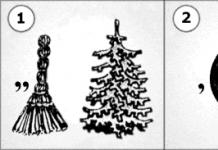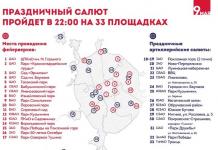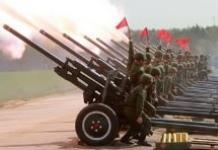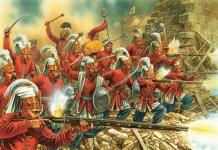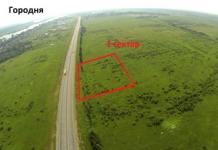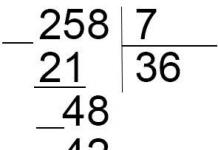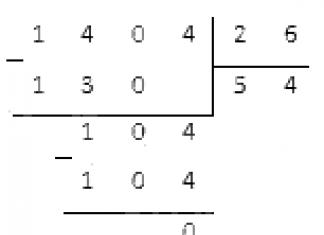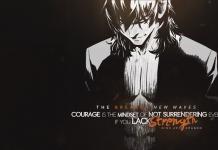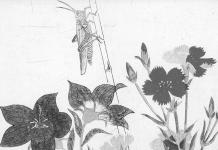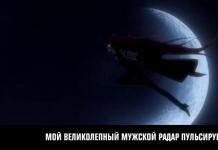|
|||||||||||||||||||||
|
History reference
The passage of the Russian-Chinese border was established by numerous legal acts - the Nerchinsk Treaty of 1689, the Burinsky and Kyakhta treatises of 1727, the Aigun Treaty of 1858, the Beijing Treaty of 1860, and the Treaty of 1911.
In accordance with generally accepted practice, borders on rivers are drawn along the main fairway. However, taking advantage of the weakness of pre-revolutionary China, the tsarist government of Russia managed to draw a border on the Ussuri River along the water's edge along the Chinese coast. Thus, the entire river and the islands on it turned out to be Russian.
This apparent injustice persisted after October revolution 1917 and the formation of the People's Republic of China in 1949, but had no effect on Soviet-Chinese relations. And only at the end of the 1950s, when disagreements arose between the leadership of the CPSU and the CCP, did the situation on the border become constantly aggravated.
The Soviet leadership was sympathetic to the desire of the Chinese to carry out new frontier along the rivers and was even ready for the transfer of a number of lands to the PRC. However, this readiness disappeared as soon as the ideological and then the interstate conflict flared up. Further deterioration of relations between the two countries eventually led to an open armed confrontation on Damansky Island.
Damansky Island in the late 60s belonged to the Pozharsky district of Primorsky Krai, bordering on the Chinese province of Heilongjiang. The distance of the island from the Soviet coast was about 500 m, from the Chinese - about 300 m. From south to north, Damansky is extended by 1500 - 1800 m, and its width reaches 600 -700 m.
These figures are quite approximate, since the size of the island is highly dependent on the time of year. For example, in spring and during summer floods, the island is flooded with the waters of the Ussuri, and it is almost hidden from view, and in winter Damansky rises among the frozen river. Therefore, this island does not represent any economic or military-strategic value.
The events of March 2 and 15, 1969 on Damansky Island were preceded by numerous provocations by the Chinese on the unauthorized seizure of the Soviet islands on the Ussuri River (starting from 1965). At the same time, the Soviet border guards always strictly adhered to the established line of conduct: provocateurs were expelled from Soviet territory, the border guards did not use weapons.
On the night of March 1-2, 1969, about 300 Chinese troops crossed to Damansky and lay down on the higher western coast of the island among bushes and trees. The trenches were not torn off, they simply lay down in the snow, laying down mats.
The equipment of the border violators was quite consistent weather conditions and was the following: a hat with earflaps, which differs from a similar Soviet earflap in the presence of two flaps on the left and right - in order to better capture sounds; padded jacket and the same cotton pants; insulated lace-up boots; cotton uniform and warm underwear, thick socks; army-style mittens - thumb and index finger separately, the rest of the fingers together.
The Chinese soldiers were armed with AK-47 assault rifles and SKS carbines. The commanders have TT pistols. All Chinese-made weapons, manufactured under Soviet licenses.
The offenders were in white camouflage coats, they wrapped their weapons with the same camouflage cloth. The ramrod was filled with paraffin - so as not to rattle.
There were no documents or personal belongings in the pockets of the Chinese.
The Chinese extended a telephone connection to their shore and lay in the snow until morning.
To support the intruders, positions of recoilless guns, heavy machine guns and mortars were equipped on the Chinese coast. Here the infantry with a total number of 200-300 people was waiting in the wings.
On the night of March 2, two border guards were constantly at the Soviet observation post, but they did not notice or hear anything - neither lights nor any sounds. The advance of the Chinese to their positions was well organized and completely covert.
At about 9:00 a.m., a border detachment consisting of three people passed through the island, the detachment did not find the Chinese. Violators also did not begin to unmask themselves.
At about 10.40, a report was received at the Nizhne-Mikhailovka outpost from the observation post that a group of up to 30 armed people was moving from the Chinese border post of Gunsy in the direction of Damansky.
The head of the outpost, Senior Lieutenant Ivan Strelnikov, raised his subordinates on command "to the gun", after which he called the operational duty officer of the border detachment.
The personnel plunged into three vehicles - GAZ-69 (7 people led by Strelnikov), BTR-60PB (about 13 people, senior - Sergeant V. Rabovich) and GAZ-63 (a total of 12 border guards, led by junior sergeant Yu. Babansky ).
GAZ-63, on which Yu. Babansky advanced with his group, had a weak engine, so on the way to the island they lagged behind the main group by 15 minutes.
Arriving at the place, the commander's "gazik" and the armored personnel carrier stopped at the southern tip of the island. Dismounting, the border guards moved in the direction of the violators in two groups: the first was led along the ice by the head of the outpost himself, and Rabovich's group walked in a parallel course directly along the island.
Together with Strelnikov, there was a photographer from the political department of the border detachment, Private Nikolai Petrov, who filmed what was happening with a movie camera, as well as with a Zorkiy-4 camera.
Approaching the provocateurs (at about 11.10), I. Strelnikov protested about the violation of the border and demanded that the Chinese military personnel leave the territory of the USSR. One of the Chinese answered something loudly, then two pistol shots rang out. The first line parted, and the second opened a sudden automatic fire on Strelnikov's group.
Strelnikov's group and the head of the outpost himself died immediately. The Chinese who ran up snatched a movie camera from Petrov's hands, but did not notice the camera: the soldier fell on him, covering him with a sheepskin coat.
The ambush on Damansky also opened fire - on Rabovich's group. Rabovich managed to shout "To battle", "but this did not solve anything: several border guards were killed and wounded, the survivors ended up in the middle of a frozen lake in full view of the Chinese.
Part of the Chinese got up from their "beds" and went on the attack on a handful of Soviet border guards. Those accepted unequal fight and fired to the last.
It was at this moment that Y. Babansky's group arrived in time. Having taken a position at some distance behind the dying comrades, the border guards met the advancing Chinese with machine gun fire.
The raiders reached the positions of the Rabovich group and here they finished off several wounded border guards with automatic bursts and edged weapons (bayonets, knives).
The only one who survived literally by a miracle was Private Gennady Serebrov. He told about the last minutes of the life of his friends.
There were fewer and fewer fighters left in the Babansky group, ammunition was running out. The junior sergeant decided to retreat to the parking lot, but at that moment the Chinese artillery covered both vehicles. The car drivers took refuge in an armored personnel carrier left by Strelnikov and tried to enter the island. They did not succeed, because the coast was too steep and high. After several unsuccessful attempts to overcome the rise, the armored personnel carrier retreated to a shelter on the Soviet coast. At this time, the reserve of the neighboring outpost, led by Vitaly Bubenin, arrived in time.
Senior Lieutenant V. Bubenin commanded the neighboring outpost of Sopka Kulebyakina, located 17-18 km north of Damansky. Having received a telephone message on the morning of March 2 about shooting on the island, Bubenin put about twenty fighters in an armored personnel carrier and hurried to the rescue of his neighbors.
At about 11.30 the armored personnel carrier reached Damansky and entered one of covered in ice duct. Hearing heavy gunfire, the border guards disembarked from the car and deployed in a chain in the direction of the gunshots. Almost immediately they ran into a group of Chinese, and a fight ensued.
The violators (still the same, in "beds") noticed Bubenin and transferred fire to his group. The senior lieutenant was wounded and shell-shocked, but did not lose control of the battle.
Leaving in place a group of soldiers led by junior sergeant V. Kanygin, Bubenin and 4 border guards plunged into an armored personnel carrier and moved around the island, going into the rear of the Chinese ambush. Bubenin himself stood up to a heavy machine gun, and his subordinates fired through the loopholes on both flanks.
Despite the multiple superiority in manpower, the Chinese found themselves in an extremely unpleasant situation: from the island they were fired on by groups of Babansky and Kanygin, and from the rear - by a maneuvering armored personnel carrier. But the Bubeninskaya car also got it: the sight was damaged by fire from the Chinese coast on the armored personnel carrier, the hydraulic system could no longer maintain the required tire pressure. The head of the outpost himself received a new wound and concussion.
Bubenin managed to bypass the island and take cover on the river bank. Having reported by phone to the detachment about the situation and then reseeding in Strelnikov's armored personnel carrier, the senior lieutenant again went out to the channel. But now he drove the car directly across the island along the Chinese ambush.
The climax of the battle came at the moment when Bubenin destroyed the Chinese command post. After that, the violators began to leave their positions, taking with them the dead and wounded. The Chinese left mats, telephones, shops, and several small arms in place of the "beds". In the same place, in a large number (almost in half of the “beds”), used individual dressing bags were found.
Having shot the ammunition, Bubenin's armored personnel carrier retreated to the ice between the island and the Soviet coast. They stopped to take on board two wounded, but at that moment the car was hit.
Closer to 12.00, a helicopter with the command of the Iman border detachment landed near the island. The head of the detachment, Colonel D.V. Leonov remained on the shore, and the head of the political department, Lieutenant Colonel A.D. Konstantinov, organized a search for the wounded and dead directly on Damansky.
A little later, reinforcements from neighboring outposts arrived at the scene. Thus ended the first combat clash on Damansky on March 2, 1969.
After the events of March 2, reinforced detachments (at least 10 border guards armed with group weapons) constantly went to Damansky.
In the rear, at a distance of several kilometers from Damansky, a motorized rifle division of the Soviet Army was deployed (artillery, Grad multiple rocket launchers).
The Chinese side also accumulated forces for the next offensive. The 24th Infantry Regiment of the National Liberation Army of China (PLA) numbering about 5,000 (five thousand military personnel) was preparing for combat operations near the island in the territory of the PRC.
At about 3:00 pm on March 14, 1969, the Imansky border detachment received an order from a higher authority: to remove the Soviet border detachments from the island (the logic of this order is not clear, just as the person who gave this order is unknown).
The border guards withdrew from Damansky, and immediately a revival began on the Chinese side. Chinese servicemen in small groups of 10-15 people began to move to the island in dashes, others began to take up combat positions opposite the island, on the Chinese coast of the Ussuri.
In response to these actions, the Soviet border guards on 8 armored personnel carriers under the command of Lieutenant Colonel E. Yanshin turned into battle formation and began to advance towards Damansky Island. The Chinese immediately withdrew from the island to their shore.
After 00.00 on March 15, a detachment of Lieutenant Colonel Yanshin, consisting of 60 border guards in 4 armored personnel carriers, entered the island.
The detachment settled down on the island in four groups, at a distance of about 100 meters from each other, dug trenches for prone firing. The groups were commanded by officers L. Mankovsky, N. Popov, V. Solovyov, A. Klyga. Armored personnel carriers constantly moved around the island, changing firing positions.
Around 9:00 am on March 15, a loudspeaker installation started working on the Chinese side. Soviet border guards were urged to leave "Chinese" territory, to renounce "revisionism", and so on.
A loudspeaker was also turned on on the Soviet coast. The broadcast was conducted in Chinese and in rather simple words: "Think about it before it's too late, before you are the sons of those who liberated China from the Japanese invaders."
After some time, silence fell on both sides, and closer to 10.00, Chinese artillery and mortars (from 60 to 90 barrels) began shelling the island. At the same time, 3 companies of Chinese infantry went on the attack.
A fierce battle began, which lasted about an hour. By 11:00, the defenders began to run out of ammunition, and then Yanshin delivered them from the Soviet coast in an armored personnel carrier.
Colonel Leonov reported to his superiors about the superior forces of the enemy and the need to use artillery, but to no avail.
At about 12.00 the first armored personnel carrier was knocked out, twenty minutes later - the second. Nevertheless, Yanshin's detachment steadfastly held its position even in the face of the threat of encirclement.
Stepping back, the Chinese began to group on their shore opposite the southern tip of the island. From 400 to 500 soldiers clearly intended to hit the rear of the Soviet border guards.
The situation was aggravated by the fact that communication between Yanshin and Leonov was lost: the antennas on the armored personnel carriers were cut off by machine-gun fire.
In order to frustrate the enemy's plan, the grenade launcher crew of I. Kobets opened well-aimed fire from his shore. This was not enough under the circumstances, and then Colonel Leonov decided to make a raid on three tanks. The tank company was promised to Leonov on March 13, but 9 vehicles came up only at the height of the battle.
Leonov took a seat in the lead car, and three T-62s moved towards the southern tip of Damansky.
Approximately at the place where Strelnikov died, the command tank was hit by the Chinese with a grenade launcher (RPG). Leonov and some crew members were injured. Leaving the tank, we headed for our shore. Here a bullet hit Colonel Leonov - right in the heart.
The border guards continued to fight in scattered groups and did not allow the Chinese to reach the western coast of the island. The situation was heating up, the island could be lost. At this time, it was decided to use artillery and bring motorized rifles into battle.
At 5:00 pm, the "Grad" installation division launched a fire attack on the places of accumulation of manpower and equipment of the Chinese and their firing positions. At the same time, the cannon artillery regiment opened fire on identified targets.
The raid turned out to be extremely accurate: the shells destroyed the Chinese reserves, mortars, stacks of shells, etc.
Artillery hit for 10 minutes, and at 17.10 motorized infantry and border guards went on the attack under the command of Lieutenant Colonel Smirnov and Lieutenant Colonel Konstantinov. The armored personnel carriers entered the canal, after which the fighters dismounted and turned towards the rampart along the western bank.
The enemy began a hasty retreat from the island. Damansky was liberated, but around 19.00 some Chinese firing points came to life. Perhaps at that moment it was necessary to deliver another artillery strike, but the command considered it inappropriate.
The Chinese tried to recapture Damansky, but three of their attempts ended in failure. After that, the Soviet soldiers retreated to their shore, and the enemy did not take any more hostile actions.
Epilogue (Russian version)
On October 20, 1969, talks were held in Beijing between the heads of government of the USSR and the PRC. The result of these negotiations: it was possible to reach an agreement on the need to carry out demarcation measures on sections of the Soviet-Chinese border. As a result: during the demarcation of the border between the USSR and China in 1991, Damansky Island went to the PRC. Now he has a different name - Zhenbao-dao.
One of the points of view widespread in Russia is that the point is not who, in the end, Damansky went to, but what the circumstances were at a particular historical moment in time. If the island were then given to the Chinese, this would in turn give rise to a precedent and encourage the then Chinese leadership for further territorial claims to the USSR.
According to many Russian citizens, in 1969, for the first time after the Great Patriotic War, real aggression was repelled on the Ussuri River, which was aimed at seizing foreign territories and resolving specific political issues.
Ryabushkin Dmitry Sergeevich
www.damanski-zhenbao.ru
Photo - http://lifecontrary.ru/?p=35
It has been 44 years since the bloody battles on Damansky Island. This epoch-making event of the 20th century, which brought the world to the brink of war, an inimitable standard of the highest patriotism, courage, heroism, unparalleled courage, selfless love and devotion to one’s Motherland, professional military skill, is little mentioned in the state official media. As if he never existed. As if we, defending our Motherland, on our, I emphasize, on our territory, did something shameful, which is embarrassing to even mention.
Shusharin Vladimir Mikhailovich was born on November 12, 1947 in the city of Kuibyshev, Novosibirsk Region. Russian. He was called up on July 3, 1966 by the Kuibyshev Military Commissariat of the Novosibirsk Region. Private, shooter of the 2nd frontier post of the 57th frontier detachment of the Pacific border district. Killed in battle on about. Damansky March 2, 1969. He was buried on March 6, 1969, in a mass grave on the territory of the 2nd frontier post "Nizhne-Mikhailovka", Pozharsky district of Primorsky Krai. He was reburied on May 30, 1980 at the military section of the city cemetery of Dalnerechensk, Primorsky Krai, the memorial "Glory to the Fallen Heroes". He was awarded the medal "For Courage" and the Badge of Honor of the Central Committee of the All-Union Leninist Young Communist League "For Military Valor" (posthumously).
“... Hello mom, dad, Sasha and Seryozha! Excuse me for not writing for a long time, I really don’t like writing letters, and there’s nothing special to write about. Alive, healthy, don't worry about me... There is nothing new, I still go to work, draw, and wait for demobilization. The weather is warm, it thaws during the day, spring is coming, here it starts early here ... Lyudmila writes often, in general, she’s done well with me.
How are you, my "oldies"! How are the bros! Seryozha has probably become big. And you, Sasha, how are things in sports? Do not be offended that I rarely deprive. Do not think that I am forgetting you, if you only knew how much I missed you all!”
 Vladimir Shusharin wrote this letter to his parents on February 27, 1969. And on March 2, when the letter had not yet reached the addressee, on the border where Vladimir served, a monstrous tragedy broke out, which everyone now knows about and which causes pain and indignation in everyone ...
Vladimir Shusharin wrote this letter to his parents on February 27, 1969. And on March 2, when the letter had not yet reached the addressee, on the border where Vladimir served, a monstrous tragedy broke out, which everyone now knows about and which causes pain and indignation in everyone ...
On the night of March 2, about three hundred armed Chinese soldiers, violating the Soviet state border, crossed the channel of the Ussuri River to the Soviet Damansky Island. Dressed in white camouflage robes, they spread out on an island in the forest and bushes, beyond the natural elevation of the area, lay in ambush. On the Chinese coast of the Ussuri, military units and fire weapons were concentrated - mortars, grenade launchers and heavy machine guns.
In the morning, another 30 armed Chinese violators set off from the Chinese coast across the state border of the USSR to Damansky Island.
The commander of the N-outpost, Senior Lieutenant Ivan Strelnikov, together with Senior Lieutenant Nikolai Buinevich, taking with him six border guards, including our fellow Kuibyshev resident Vladimir Shusharin, went out to meet the violators, intending to protest to the Chinese and demand that they leave Soviet land . So the border guards acted repeatedly when Chinese violators appeared in these places. The provocateurs approached Strelnikov's group and suddenly opened fire on it point-blank...
... A large two-story house on the main street of the city seemed to grow dark and quiet. Near the gate are three old women, quietly talking:
What a guy he was! He won't hurt anyone, he'll get along with everyone...
It's about him, about Vladimir. He lived in this house before being drafted into the army, walked along these alleys of the garden, climbed these steps to the eleventh apartment, in which a great, unbearable grief has now settled. A thin woman, exhausted from tears, bent over the photographs laid out on the table. Who can't understand a mother's heart! It is not easy, oh how difficult it is for Anastasia Zinovievna to come to terms with a heavy loss.
The eldest son died. The mother is crying, but along with tears, a harsh condemnation of impudent provocateurs boils in her heart, pride is heard for her son, who heroically gave his life for the inviolability of the sacred borders of our Motherland. The same feeling of pride lives in Vladimir's father, Isai Pavlovich. I heard him say at a rally of energy workers at the Barabinsk State District Power Plant:
Our son died from bandit hands while defending the borders of the Motherland. It's hard for us parents. But we know that he didn't flinch Hard time, to the end he fulfilled his soldier's duty. Vladimir grew up in a good family. They brought him up in a good way, managed to instill in him high moral qualities. Parents, the school, the team in which he worked before leaving for the army must be given credit for the fact that a real hero has grown out of a former naughty boy.
Vladimir Shusharin enjoyed special love among the border guards. He was considered in the unit as his artist. While still at school, Vladimir was fond of painting, studied in a circle of fine arts. After school, this hobby did not leave him. A circle of drawing lovers worked in the Palace of Culture named after V. V. Kuibyshev. Vladimir Shusharin, a mechanic at motor depot No. 8, was also a regular participant. In the army, in his free time, he usually took a pencil or a brush and, having settled down somewhere in the rest room or on the street, near the outpost, he drew. The Leninsky room of the outpost is decorated and framed by his hands.
Vladimir began his military service in the most "prosaic" way. While still at home, he trained as a locksmith. Therefore, he was sent to a unit where people who knew the technique were needed. But a few months later, the guy asked to go to the border, and his request was granted.
On that fateful morning of March 2, Vladimir Shusharin, together with his friends, was the first to meet the violators. He, like the head of the outpost I. Strelnikov, like all his comrades, did not want blood to be shed on the Ussuri ice. They demanded from provocateurs that they get out of foreign territory. Eight Soviet border guards stopped against thirty Chinese bandits. They were asked to change their minds, and they went on a malicious provocation, opened fire on the border guards. Vladimir Shusharin fell one of the first. Two automatic bursts pierced the chest of a soldier ...
There were many times fewer of them than Chinese bandits. Taking advantage of this, the provocateurs sneered at the wounded and killed. As if fearing that the dead would rise, they continued to barbarously deal with the corpses. But provocateurs paid dearly for the lives of the dead Soviet soldiers. Despite the incomparable superiority in forces, they suffered heavy losses and were thrown out of Soviet soil.
… Once upon a time civil war there, in the East, Vladimir's great-grandfather died from a bullet of a White Guard. Later, in the same place, in the east, he guarded the borders of the Motherland, and later heroically fought in the west with the Nazis, his grandfather Zinovy Nikitich Kuzmin, who now lives in our city. wounded, old man, he has many government awards. Vladimir Shusharin did not disgrace the honor of the older generation. He courageously accepted death, defending the inaccessibility of the borders of his beloved Motherland.
“Dear Anastasia Zinovievna and Isai Pavlovich! Your son, Private Shusharin Vladimir Mikhailovich, on March 2, 1969, died a heroic death while guarding and defending the state border of the USSR. Command and Political Administration border troops Soviet Union express their deepest condolences to you. The feat of your son is a vivid example of selfless service to our great Soviet Motherland, to the cause of communism. The bright memory of your son, a faithful and courageous defender of the socialist Fatherland, will forever remain in the hearts of his fighting friends, border guards and the entire Soviet people.
Such a letter was received by Vladimir's parents from the command and political administration of the border troops of the USSR. Everyone adds their voice to the words of this letter. Soviet people, we will always be proud of the feat of our fellow countryman. There, at the outpost of Strelnikov, the soldiers still carry out their difficult service. And, every time, going on patrol, they come to the mass grave to take an oath of allegiance to the fallen comrades. And we know that the border is closed again, that the work of Vladimir Shusharin and his friends is reliably continued by other Soviet soldiers.
March 2, 1969 Chronicle of events
On the night of March 1-2, 1969, about 300 Chinese military personnel in winter camouflage, armed with AK assault rifles and SKS carbines, crossed to Damansky Island and lay down on the western coast of the island. At 10:40, a report was received from the observation post at the 2nd outpost "Nizhne-Mikhailovka" of the 57th Imansky border detachment that a group of armed people numbering up to 30 people was moving in the direction of Damansky. An alarm group of 32 Soviet border guards under the command of the head of the outpost, senior lieutenant Ivan Strelnikov, drove to the scene in GAZ-69 and GAZ-63 vehicles and an armored personnel carrier BTR-60PB.At 11:10 Gaz-69 and BTR-60 arrived at the southern tip of the island.
 Alarm group of the 2nd frontier post at about. Damansky. Photograph by an unknown Chinese military photographer
Alarm group of the 2nd frontier post at about. Damansky. Photograph by an unknown Chinese military photographer
Arriving at the place of violation of the border, the border guards split into two groups. The first, of 7 people under the command of Strelnikov, went to the Chinese soldiers who were standing on the ice of the river southwest of the island. The second group of 13 border guards, led by Sergeant Vladimir Rabovich, was supposed to cover Strelnikov's group, moving along the southern coast of the island.
The beginning of the armed provocation was captured by a military photographer, Private Nikolai Petrov, who photographed and filmed the events, recording the fact of border violations and the procedure for expelling violators. The Chinese soldiers took away a movie camera with them, but did not notice the camera, which Petrov, after taking the last picture, put it behind the lapel of his sheepskin coat...
 The first photo of Petrov, taken from a distance of 300-350 m, shows soldiers of the Chinese army who violated the state border.
The first photo of Petrov, taken from a distance of 300-350 m, shows soldiers of the Chinese army who violated the state border.
The second picture clearly shows a chain of Chinese and three border guards walking towards them. On the right is the coast of Damansky Island: somewhere there, among the trees and bushes, a Chinese ambush lurked.
 Approaching the Chinese, I. Strelnikov protested about the violation of the border and demanded that the Chinese military personnel leave the territory of the USSR. One of the Chinese shouted something loudly to his soldiers, after which those in front parted, and those behind opened automatic fire on our border guards. The last shot was taken by Petrov a few moments before his death: the nearest Chinese soldier raised his hand - most likely, this is a signal to open fire.
Approaching the Chinese, I. Strelnikov protested about the violation of the border and demanded that the Chinese military personnel leave the territory of the USSR. One of the Chinese shouted something loudly to his soldiers, after which those in front parted, and those behind opened automatic fire on our border guards. The last shot was taken by Petrov a few moments before his death: the nearest Chinese soldier raised his hand - most likely, this is a signal to open fire.
 Strelnikov, Buinevich and the border guards accompanying them died immediately. The ambush on Damansky opened fire on Rabovich's group. Several border guards were killed, the survivors lay down and opened fire on the Chinese who rushed to the attack. They fought to the last bullet...
Strelnikov, Buinevich and the border guards accompanying them died immediately. The ambush on Damansky opened fire on Rabovich's group. Several border guards were killed, the survivors lay down and opened fire on the Chinese who rushed to the attack. They fought to the last bullet...
The only one who miraculously survived from the group of Sergeant Rabovich was Private Gennady Serebrov. Having regained consciousness in the hospital, he spoke about the last moments of the life of his friends:
- Our chain stretched along the coast of the island. Pasha Akulov ran ahead, followed by Kolya Kolodkin, then the rest. Yegupov ran ahead of me, and then Shusharin. We were chasing the Chinese, who were leaving along the rampart towards the bush. There was an ambush. As soon as they jumped out onto the rampart, they saw three Chinese soldiers in camouflage suits below. They lay three meters from the rampart. At this time, shots were fired at Strelnikov's group. We opened fire in response. Several Chinese in the ambush were killed. Shot in long bursts...
March 2, 1969 11-25
A group of border guards arrived at the battlefield junior sergeant Babansky suffered heavy losses, fighting off the pressing Chinese. Ammo ran out. “After 20 minutes of the battle,” Yury Babansky recalled, “out of 12 guys, eight remained alive, after another 15 - five. Of course, it was still possible to retreat, return to the outpost, wait for reinforcements from the detachment. But we were seized with such fierce anger at these bastards that in those moments we wanted only one thing - to put as many of them as possible. For the guys, for ourselves, for this span of land that no one needs, but still our land ... Suddenly we heard a completely wild obscenity and a rolling “hurray!” - it was from the other side of the island that guys from the neighboring outpost of Senior Lieutenant Bubenin rushed to our rescue. The Chinese, leaving the dead, rushed to their shore, and for a long time I could not believe that death had passed by ... "Senior Lieutenant Vitaly Bubenin commanded the Kulebyakiny Sopki outpost, located fifteen kilometers north of Damansky. Having received a telephone message about what was happening on the island, he hurried with twenty-two border guards in an BTR-60 to help his neighbors ...
March 2, 1969 Damansky Island. Report of the head of the 1st frontier post, Lieutenant Bubenin, via the communication line to the operational duty officer of the 57th border detachment, Major V. Bazhenov:
I report the situation: there is a battle on the island ... on Damansky Island, a battle has been going on for about an hour. Strelnikov? Apparently, his outpost and he died ... Yes, I personnel 21 people are fighting ... Yes, a lot ... heavy fire from mortars, artillery ... automatic and machine-gun fire. Everything is on fire, my armored personnel carrier has been hit, there are dead and wounded... I can’t hear you... I can’t hear you...
The driver of the armored personnel carrier corporal A. Shamov takes the phone.
Comrade Major, Senior Lieutenant Bubenin is losing consciousness... yes, he is seriously wounded, covered in blood, burned... No, he seems to be alive... regaining consciousness.
Yes, I'm Bubenin, I'm listening to you ... Bring people out? No I can not. An open place, they will put everyone, I will lose everyone. My reserve came up, I'm going into battle again. No, I can't, Major... I can't retreat, I'm going into battle, that's all... Farewell...
At that moment, help arrived - a group of sergeant Sikushenko arrived from the 1st outpost, and Bubenin, having transferred with seven border guards to the Strelnikov armored personnel carrier, continued the attack ...
From the memoirs of Vitaly Bubenin: “I fought all the further battle on the subconscious, being in some other world. Having got out on the shore and sat in an armored personnel carrier, the fighters and I went to the rear of the enemy. In front of the car, the dumbfounded Chinese got up from under the snow one by one. Only then did we realize how many of them came to our souls ... For more than two hours of fighting, we circled around their positions, crushing and shooting. When, after the next round, we got to the other side, it turned out that four out of the entire outpost were left on their feet. We sent the dead and wounded to the outpost, silently embraced, stood for a while and went back towards the island. Everyone understood that he would not return from this battle.
In the last attack, Bubenin managed to destroy the command post of the Chinese battalion on the island. This decided the outcome of the battle. Chinese soldiers began to retreat to their territory, taking with them the wounded and dead ...
Vladimir Grechukhin, photographer of the district newspaper “Border Guard on pacific ocean”, ended up on the island an hour and a half after the end of the battle. It smelled of gunpowder, blood, death ...
 Burnt out GAZ-69 of the 2nd frontier post. Damansky Island. March 2, 1969
Burnt out GAZ-69 of the 2nd frontier post. Damansky Island. March 2, 1969  A shell hole in the starboard side of the BTR-60 No. 04 of the 2nd frontier post
A shell hole in the starboard side of the BTR-60 No. 04 of the 2nd frontier post  At the position of the Chinese battalion
At the position of the Chinese battalion 
 Chinese command post destroyed by Bubenin's group
Chinese command post destroyed by Bubenin's group
On March 2, 1969, up to 250 Chinese soldiers and 31 Soviet border guards were killed in the battle near Damansky Island, 14 were injured. Komsomol organizer of the Nizhne-Mikhailovka outpost, Corporal Akulov, went missing ...
March 2, 1969 12-00
A helicopter landed near the island with the command of the Iman border detachment. The head of the political department, lieutenant colonel A.D. Konstantinov, organized a search for the wounded and dead directly on Damansky.From the memoirs of Lieutenant Colonel Konstantinov:
Everything around was burning: bushes, trees, two cars. We flew over our territory, watching Damansky. We saw our soldiers near some tree and landed. I began to send groups of soldiers in search of the wounded, the road was every minute. Babansky said that they found Strelnikov and his group. We crept in there like a plastuna. They lay so close together. First of all, I checked the documents. At Buinevich - on the spot. At Strelnikov's, they disappeared. Private Petrov, sent to the outpost by the political department for film and photo documentation, lost his camera. But under a sheepskin coat we found a camera with which he took his last three shots, which went around the whole world.
They broke branches, laid down the corpses and, standing up to their full height, went to their own. The soldiers dragged the bodies, and the officers and I fell a little behind - with machine guns and machine guns, we covered the retreat. So they left. The Chinese did not open fire ...
Junior Sergeant Alexander Skornyak recalls:
- We went out onto the ice, where the guys died, drove the GAZ-69 cars and started loading the bodies in twos, threes. Some of them were still warm, you see, only recently died from their wounds. You start to lift the guy, and he has a fountain of blood from his mouth. I still remember the smell of blood in the cold, the smell of death. The Chinese even mocked the dead - they stabbed with bayonets. The officers Buynevich and Strelnikov especially got it. The snow was red with blood. The Chinese carried away their dead during the retreat. But we found one of their soldiers between ours. He was dressed warmly, there was an AK-47 assault rifle and a field telephone nearby ...
“Our people were tortured both alive and after death. They cut, smashed their heads ... - said Vladimir Grechukhin. - The Chinese dragged off the seriously wounded Komsomol organizer of the Nizhne-Mikhailovka outpost, Corporal Pavel Akulov. I was at the time of the transfer of his body to relatives - the remnants of his hair are gray. Pavel's corpse was mutilated beyond recognition. And only the mother was able to identify her son by a mole on his index finger ...
Chinese soldiers finished off wounded Soviet border guards with point-blank shots and edged weapons. This shameful fact for the People's Liberation Army of China is evidenced by the documents of the Soviet medical commission.
From the report of the head of the medical service of the 57th border detachment, major of the medical service V.I. found that 19 of the wounded would have remained alive, because during the battle they received non-fatal wounds. But then, in a fascist way, they were finished off with knives, bayonets and rifle butts. This is irrefutably evidenced by cut, stab bayonet and gunshot wounds. They shot point-blank from one or two meters. From such a distance, Strelnikov and Buinevich were finished off.
On March 5 and 6, border guards were buried at the outposts. Grechukhin's photographs show rows of coffins. Strict faces of the dead. Many have their heads hidden under white gauze bandages...


 The funeral of the dead at the Nizhne-Mikhailovka outpost. March 6, 1969
The funeral of the dead at the Nizhne-Mikhailovka outpost. March 6, 1969
Junior Sergeant Alexander Skornyak says:
Our guys were buried on the third day. The generals arrived from the district. The parents of the victims arrived. The political department campaigned for everyone to be buried in Nizhne-Mikhailovka, at the frontier post. All the fallen were immediately posthumously awarded: officers were awarded the title of Hero of the Soviet Union, sergeants and soldiers were awarded orders. But that didn't make it any easier. And no one could have imagined that soon the dead border guards and soldiers would be laid next to them again ...
Background to the conflict
The passage of the Russian-Chinese border in the Far East was established by the Nerchinsk Treaty of 1689, the Burinsky and Kyakhta treatises of 1727, the Aigun Treaty of 1858, the Beijing Treaty of 1860, and the Treaty of 1911. According to Article 1 of the Beijing Treaty, “the lands lying on the right bank (to the south), up to the mouth of the Ussuri River, belong to the Chinese state. Further, from the mouth of the Ussuri River to Lake Khinkai, the boundary line runs along the Ussuri and Sungacha rivers. The lands lying ... along the western (left) - the Chinese state.After the Paris Peace Conference of 1919, a provision appeared that the borders between states should, as a rule (but not necessarily) pass in the middle of the main fairway of the river. But it also provided for exceptions, such as drawing a border along one of the coasts, when such a border developed historically - by agreement, or if one side colonized the second coast before the other began to colonize it. In addition, international treaties and agreements do not have retroactive effect.
Despite the fact that, according to earlier agreements, the entire Ussuri River and the islands located on it turned out to be Russian, this did not have any effect on Soviet-Chinese relations. Only in the late 1950s, when the PRC, seeking to increase its international influence, came into conflict with Taiwan (1958) and participated in the border war with India (1962), did the Chinese use the new border provisions as an excuse to revise the Soviet-Chinese borders.
The Soviet leadership was sympathetic to the desire of the Chinese to draw a new border along the rivers and was even ready to transfer a number of lands to the PRC. However, this readiness disappeared as soon as the ideological and then the interstate conflict flared up. Further deterioration of relations between the two countries eventually led to an open armed confrontation on Damansky Island.
The events of March 2 and 15, 1969 on Damansky Island, starting from 1965, were preceded by numerous provocations by the Chinese to arbitrarily seize the Soviet islands on the Ussuri River. At the same time, the Soviet border guards always strictly adhered to the established line of conduct: provocateurs were expelled from Soviet territory, the border guards did not use weapons.
History reference.Border guards of the 57th Imansky border detachment who died in battle on March 2, 1969
Damansky Island in the late 60s belonged to the Pozharsky district of Primorsky Krai, bordering on the Chinese province of Heilongjiang. The removal of the island from the Soviet coast was about 500 m, from the Chinese - about 300 m. From south to north, Damansky is extended by 1500-1800 m, and its width reaches 600-700 m. The actual size of the island strongly depends on the time of year and the level of flood waters . It has no economic or military-strategic value.
- Art. Lieutenant Buinevich Nikolai Mikhailovich, detective of the special department of the 57th border detachment.
- Sergeant Ermolyuk Viktor Mikhailovich
- Corporal Korzhukov Viktor Kharitonovich
- Private Vetrich Ivan Romanovich
- Private Gavrilov Viktor Illarionovich
- Private Zmeev Alexey Petrovich
- Private Izotov Vladimir Alekseevich
- Private Ionin Alexander Filimonovich
- Private Syrtsev Alexey Nikolaevich
- Private Nasretdinov Islamgali Sultangaleevich
- Senior Lieutenant Strelnikov Ivan Ivanovich
- Sergeant Dergach Nikolay Timofeevich
- Sergeant Rabovich Vladimir Nikitich
- Junior Sergeant Kolodkin Nikolai Ivanovich
- Junior Sergeant Mikhail Andreevich Loboda
- Corporal Akulov Pavel Andreevich (died in captivity from his wounds)
- Corporal Davydenko Gennady Mikhailovich
- Corporal Mikhailov Evgeny Konstantinovich
- Private Danilin Vladimir Nikolaevich
- Private Denisenko Anatoly Grigorievich
- Private Egupov Viktor Ivanovich
- Private Zolotarev Valentin Grigorievich
- Private Isakov Vyacheslav Petrovich
- Private Kamenchuk Grigory Alexandrovich
- Private Kiselev Gavriil Georgievich
- Private Kuznetsov Alexey Nifantevich
- Private Nechay Sergey Alekseevich
- Private Ovchinnikov Gennady Sergeevich
- Private Pasyuta Alexander Ivanovich
- Private Petrov Nikolai Nikolaevich
- Private Shestakov Alexander Fedorovich
- Private Shusharin Vladimir Mikhailovich
 Memorial plaque on the mass grave of the border guards of the Nizhne-Mikhailovka outpost
Memorial plaque on the mass grave of the border guards of the Nizhne-Mikhailovka outpost TASS message
On the night of March 2, about 300 armed Chinese soldiers, violating the Soviet state border, crossed the channel of the Ussuri River to Damansky Island. This group, dressed in white camouflage robes, dispersed on the island, lay in an ambush. On the Chinese coast of the Ussuri, military units and firepower were concentrated - mortars, grenade launchers and heavy machine guns.At 04:10 Moscow time, another 30 armed violators set off from the Chinese coast across the state border of the USSR to Damansky Island. A group of Soviet border guards led by the head of the outpost, Strelnikov, came to the place of violation of the border on the Ussuri ice.
As before, the border guards intended to protest against the Chinese about the violation of the border and expel them from the territory of the Soviet Union. Fire was opened on the Soviet border guards, and they were literally shot at point-blank range. Artillery and mortar fire was opened on another group of border guards from the Chinese coast.
Together with the reinforcements that arrived from the neighboring outpost, the Soviet border guards expelled the violators.
TASS, March 9, 1969




 In March-April 1969, protest rallies were held in the city and the region against the Chinese provocation on the Soviet border and meetings with border guards participating in the battles near Damansky Island.
In March-April 1969, protest rallies were held in the city and the region against the Chinese provocation on the Soviet border and meetings with border guards participating in the battles near Damansky Island.
From the newspaper "Working Life". Kuibyshev NSO
Feat on Damansky Island
Sacred are your borders, Motherland!We angrily stigmatize the Maoist bandits.
1
We are on the high, snowy bank of the Ussuri River, at the Nizhne-Mikhailovka frontier post.
Ussuri is a dazzling white, tightly arched horseshoe covered with ice and snow. On our side, the hills in the unfallen oaks roll, wave after wave, to the distant cape. And on the other side - a lowland, red grasses, bushes ... There - China! From the border tower, through the eyepieces of the rangefinder, you can see dry crowns of trees, a fanza under red tiles, smoke ... Between these shores lies Soviet land - Damansky Island, that small island, two kilometers long, where the snow is now torn open by mines, strewn with spent shells, watered with blood .
Ten days ago, on March 2, as already reported in the press, here, on Damansky Island, a small detachment of Soviet border guards took an unequal oh with a Chinese battalion specially trained for sabotage, vilely, under cover of night, violated the Soviet border. The gang of violators was supported from the Chinese coast by an anti-tank battery, heavy mortars, grenade launchers ...
Maoist bandits were defeated and expelled from Soviet soil. But 29 Soviet soldiers and 2 officers died a heroic death in the battle for their homeland.
2
The border guard officer leads us to a pile of equipment abandoned by the Chinese. Here are tin flasks with the remnants of the hypocrite - they drank it all night before the provocation. Here are the shabby mats - the Chinese lay on them after they stole onto the island like thieves at night and hid. Here is a telephone cable, telephones in red plastic cases, through which a command was transmitted from the island to the firing positions of guns and mortars to open fire on Soviet border guards. And from all this - a stupefying, nauseating smell of spilled prude.
We were shown the helmets of our fallen fighters, new green helmets, shot through, with petals of torn metal. There was blood on the straps. It can be seen that the bullet went from top to bottom: they shot at the wounded border guards lying on the snow from the closest distance.
Major of the medical service Vyacheslav Ivanovich Vitko made the following statement to us:
- A special medical examination established that 19 of our border guards, who at first received non-fatal wounds in the leg, arm, shoulder, were then brutally, vilely finished off. This is irrefutably evidenced by cut, bayonet and gunshot wounds. Shot from a distance of one or two meters. So the Maoist bandits finished off the wounded senior lieutenant Strelnikov with a shot at close range. About these atrocities, military doctors - lieutenants of the medical service B. Potavenko, N. Kostyuchenko and I drew up an act. 19 wounded Soviet border guards would have been alive if the killers had not finished them off with knives, bayonets, and bullets.
3
Helicopters one after another descended from the hill. From them, from the approaching cars, the mothers and fathers of the fallen soldiers came out and ran along the snowy slope, flooded with a dazzlingly bright sun, to where they could hear the fading, then the growing sounds of the funeral march ...
Tightly pitched tent. Guard of honor with machine guns. The red color hits the eyes: the coffins lined with kumach stand in a row. And in them, frozen, beautiful, despite the terrible wounds, the faces of our soldiers.
Mothers run. They fall for one, for another. Not the one, not the one... There he is! And he falls dead on his son's body, kisses his wounds, grabs his hands, sobs inconsolably. And nearby - another, third ... We stand right there and, unable to hold back tears, listen, write down everything, as it was said here, how it escaped from the mother's heart.
“My son, my hope… What have they, the monsters, done to you… Yes, they cut you all over, stabbed you… You wrote to me that your forelock is growing, but they smashed your whole head…
... The young widow grabbed the stake of the tent: she looks, looks at the one in the coffin, bandaged ...
... The gray-haired father is crying, the soldiers standing in the guard of honor are wiping their tears. The reporter writes something in a notebook, sobbing ...
They carried them on their shoulders and placed them carefully under the sun. Scarlet kumach and a green line of border caps. They lay, young, surrounded by a dense crowd. The sky above them is high, and spring clouds float in it. And in these white flying clouds, it was as if there was still an echo of the recent victorious battle. And there, on the island, their blood burns...
Fallen soldiers are lying, and workers from Iman say goodbye to them, peasants from the surrounding villages, friends, comrades in the border service, officers, generals ... Smoke from a rifle salute flowed over the river. A wide mass grave, native land accepts them. The first handfuls hit the lids of the coffins. And Ussuri, white, bright, opened the wings of her sleeves over this sacred grave.
4
Military hospital. Here lie the wounded heroes of Damansky Island. Twenty-year-old guys, but already scorched by the fire of the first brutal battle in their lives. Here, along with them, their combat commander, Senior Lieutenant Vitaly Dmitrievich Bubenin. He is thirty years old. He was born in Nikolaevsk-on-Amur, in the family of a party worker. After graduating from a technical school, he worked as a mechanic. Then - the army, the border school and, finally, the outpost. He served as political officer at the outpost of Nizhne-Mikhailovka, with Senior Lieutenant Ivan Ivanovich Strelnikov. The same age, young officers, they became friends. Then Bubenin was appointed head of the neighboring outpost. Bubenin fought heroically in battle, captivating all the fighters.
He talks about what remains in the memory and in the heart for life.
Senior Lieutenant Vitaly Bubenin:
- Exactly at eleven o'clock on the second of March, the duty officer from the outpost of my friend, Senior Lieutenant Strelnikov, called us. At Damansky, the battle was already in full swing. Out of fear, we went there. We jumped out onto the island, and here we were met from three sides by Chinese cannons, mortars, grenade launchers. The intensity of the fire was great. I got hurt. I lost consciousness for a minute... When the Chinese knocked out an armored personnel carrier, we moved into another vehicle. And again - bypassing the island ... And I will tell you in honor, the guys fought for their native Soviet land, like lions. Every single one, not sparing life. As a commander, I can only be proud of them.
Private Mikhail Putilov:
- During the battle, we see - two of our wounded are crawling in the snow. We go straight to them. They began to pick them up, and in our armored transporter the Chinese fired cannons. They pierced the "stern" - they wounded us. And the commander too. But we gave them the right amount too... I was lying by a tree, wounded, and I saw how the Chinese were carrying away the dead and wounded from the island, fleeing to their side...
Private Gennady Serebrov:
- I got hit by bullets right hand and leg. I lay there and saw how they committed atrocities on my wounded comrades - Shusharin and Yegupov. Killed them, you bastards...
We also talked with Colonel D.V. Leonov, the combat commander of the border guards.
“Young guys are coming to serve us. Such a young man puts on a soldier's overcoat, and you think: will he make a real warrior, a combat defender of the Motherland? In the battle on Damansky Island, ours were true heroes. And there is nothing surprising in this. After all, the guy was raised by his father and mother, school, Komsomol, Soviet authority, our party. A wonderful Russian woman, Agniya Andreevna Strelnikova, raised ten children. Senior lieutenant Strelnikov was a talented commander. On May 9, on Victory Day, he would have turned thirty years old ... Strelnikov went to the island with fighters to reason with the violators of the border, to demand that our Soviet land be cleared, as happened more than once before. And what about them?!.. They shot Strelnikov point-blank.
Strelnikov's friend, Senior Lieutenant Bubenin, who is now in the hospital, especially distinguished himself in battle. I drove up to the battlefield and saw our friends, the local fishermen Avdeevs, carrying the wounded Bubenin in their arms. His face is covered in blood. We put the senior lieutenant under a tree. I order the doctor to evacuate him immediately.
“I won’t go, Comrade Colonel,” Bubenin objected. “There, in the fire, are my soldiers, and I’m supposed to be with them to the end.”
He got up, but his legs could not hold: apparently, he had lost a lot of blood ... Together with the doctor, we nevertheless put him in the car and sent him to the hospital. What else can I say?.. Real heroes fought on Damansky Island, loyal soldiers of our socialist Fatherland!
5
When the March clear day faded, relatives and friends, comrades of the fallen gathered for the feast. The father of Senior Lieutenant Strelnikov, Ivan Matveevich, gets up. In the Patriotic War, he was a soldier, received 12 wounds.
“Only now we have buried our children,” he said. “I have other sons, and each of them would do the same as Ivan. I can't say more.
The father of the border guard Nikitin got up:
- All of us, fathers, have passed Patriotic war… Today we lost our sons, but the people will not forget them. I curse Mao and his accomplices, this is their dirty work.
Says the father of Sergeant Nikolai Dergach - Timofey Nikitich.
“I turn fifty tomorrow. This is how things turned out... Mao killed my only son... Kolya was only twenty years old, he was just beginning to live... Now, in peacetime, I am a state farm worker. And in the Patriotic War I was an artilleryman. And, by the way, in the forty-fifth year, he came to China with his regiment to drive the Japanese out of Chinese soil. What does it get? We defeated the Kwantung Army of the Japanese imperialists in order to help the Chinese people. After 1949, plants and factories helped China build. And Mao executes real communists at home and swears at our Soviet land ... Apparently, his deeds are bad, the Chinese people do not believe him, and therefore he is looking for salvation in black robbery.
* * *
... We left the border in the evening. The sun was finishing its journey, gilding the snowy forests, the white hills, the hushed Ussuri and our Damansky Island crouching on its chest.
Here are the first stars in the sky. They will shine over the mass grave. A little time will pass - an obelisk will rise here. And he, like an eternal sentry, will guard the dream of the heroes of Damansky.
Private Vladimir Shusharin
 Commendation sheet of the city committee of the Komsomol. 1962 From the archive high school No. 4. Kuibyshev NSO.
Commendation sheet of the city committee of the Komsomol. 1962 From the archive high school No. 4. Kuibyshev NSO.  Vladimir Shusharin with friends before being drafted into the army. 1966 From the personal archive of Valery Kubrakov
Vladimir Shusharin with friends before being drafted into the army. 1966 From the personal archive of Valery Kubrakov  The notice of the death of Private Shusharin dated March 11, 1969, stored in the archives of the Kuibyshev RVC, was signed by Colonel Leonov. On March 15, the head of the 57th Imansky border detachment, Colonel Democrat Vladimirovich Leonov, died in a battle near Damansky Island
The notice of the death of Private Shusharin dated March 11, 1969, stored in the archives of the Kuibyshev RVC, was signed by Colonel Leonov. On March 15, the head of the 57th Imansky border detachment, Colonel Democrat Vladimirovich Leonov, died in a battle near Damansky Island  Entry in the book of irretrievable losses of the Kuibyshev RVC
Entry in the book of irretrievable losses of the Kuibyshev RVC An extract from the Survey Report, compiled by the head of the medical service of the 57th border detachment, Major V. I. Kvitko: “Private Shusharin Vladimir Mikhailovich, born in 1947. Multiple bullet wounds in the chest and anterior abdominal wall. Death came from damage to the organs of the chest and abdominal cavity.
Memorial "Glory to the Fallen Heroes"
 Commemorative memorial "Glory to the fallen heroes". Dalnerechensk. 2008
Commemorative memorial "Glory to the fallen heroes". Dalnerechensk. 2008 


 Registration card of a military burial in the city of Dalnerechensk from the Central Archive of the Ministry of Defense of the USSR. With her help, it was possible to establish the date of birth of Vladimir Shusharin - November 12, 1947.
Registration card of a military burial in the city of Dalnerechensk from the Central Archive of the Ministry of Defense of the USSR. With her help, it was possible to establish the date of birth of Vladimir Shusharin - November 12, 1947. On the other side of the border
 The events of 1969 on Damansky Island became a symbol of the victory of Chinese weapons over Soviet revisionism
The events of 1969 on Damansky Island became a symbol of the victory of Chinese weapons over Soviet revisionism  Ten PLA soldiers were awarded the title of "Hero of China"
Ten PLA soldiers were awarded the title of "Hero of China"  Hero of the People's Republic of China Zhou Denguo, who was the first to open fire on Soviet border guards on March 2, 1969
Hero of the People's Republic of China Zhou Denguo, who was the first to open fire on Soviet border guards on March 2, 1969 In the official interpretation of Beijing, the events on Damansky looked like this:
“On March 2, 1969, a group of Soviet border troops numbering 70 people with two armored personnel carriers, one truck and one passenger car invaded our island of Zhenbaodao, Hulin County, Heilongjiang Province, destroyed our patrol and then destroyed many of our border guards with fire. This forced our soldiers to take self-defense measures.
On March 15, the Soviet Union, ignoring the repeated warnings of the Chinese government, launched an offensive against us with the forces of 20 tanks, 30 armored personnel carriers and 200 infantry, with air support from their aircraft.
Courageously defending the island for 9 hours, the fighters and the people's militias withstood three enemy attacks. On March 17, the enemy, using several tanks, tractors and infantry, tried to pull out a tank that had been hit earlier by our troops. The hurricane return artillery fire of our artillery destroyed part of the enemy forces, the survivors retreated.
 A commemorative bas-relief narrating the heroic deeds of soldiers of the People's Liberation Army of China (PLA) in March 1969
A commemorative bas-relief narrating the heroic deeds of soldiers of the People's Liberation Army of China (PLA) in March 1969
The book "Myths of Damansky"
Book by D.S. Ryabushkin "Myths of Damansky" is dedicated to the military border conflicts of March 1969 on Damansky Island. These dramatic events destroyed the "great friendship" between the USSR and the PRC and almost led to a limited nuclear war between them.The book uses extensive documentary and literary material, eyewitness accounts. The text is accompanied by illustrations, documentary and reference applications.
Intended for a wide range of readers interested in military history. Published in 2004 with a circulation of only 3,000 copies.
Have you read the article to the end? Please take part in the discussion, express your point of view, or simply rate the article.
After the Paris Peace Conference of 1919, a provision appeared that the borders between states should, as a rule (but not necessarily), run along the middle of the main fairway of the river. But it also provided for exceptions, such as drawing a border along one of the coasts, when such a border developed historically - by agreement, or if one side colonized the second coast before the other began to colonize it.
In addition, international treaties and agreements do not have retroactive effect. Nevertheless, in the late 1950s, when the PRC, seeking to increase its international influence, came into conflict with Taiwan (1958) and participated in the border war with India (1962), the Chinese used the new border provisions as an excuse to revise the Soviet -Chinese border.
The leadership of the USSR was ready to go for it, in 1964 a consultation was held on border issues, but ended to no avail.
In connection with ideological differences during the Cultural Revolution in China and after the Prague Spring of 1968, when the PRC authorities declared that the USSR had embarked on the path of "socialist imperialism", relations became especially aggravated.
Damansky Island, which was part of the Pozharsky district of Primorsky Krai, is located on the Chinese side of the main channel of the Ussuri. Its dimensions are 1500-1800 m from north to south and 600-700 m from west to east (an area of about 0.74 km²).
During the flood period, the island is completely hidden under water and does not represent any economic value.
Since the early 1960s, the situation around the island has been heating up. According to the statements of the Soviet side, groups of civilians and military personnel began to systematically violate the border regime and enter Soviet territory, from where they were expelled each time by border guards without the use of weapons.
At first, on the instructions of the Chinese authorities, peasants entered the territory of the USSR and defiantly engaged in economic activity: mowing and grazing, claiming to be in Chinese territory.
The number of such provocations increased dramatically: in 1960 there were 100 of them, in 1962 - more than 5,000. Then the Red Guards began to attack border patrols.
The number of such events was in the thousands, each of them involved up to several hundred people.
On January 4, 1969, a Chinese provocation was carried out on Kirkinsky Island (Qiliqingdao) with the participation of 500 people.
According to the Chinese version of events, the Soviet border guards themselves organized provocations and beat up Chinese citizens who were engaged in economic activities where they always did it.
During the Kirkinsky incident, they used armored personnel carriers to oust civilians and crushed 4 of them, and on February 7, 1969, they fired several single automatic shots in the direction of the Chinese border detachment.
However, it has been repeatedly noted that none of these clashes, no matter whose fault they occurred, could result in a serious armed conflict without the approval of the authorities. The assertion that the events around Damansky Island on March 2 and 15 were the result of an action carefully planned by the Chinese side is now the most widely spread; including directly or indirectly recognized by many Chinese historians.
For example, Li Danhui writes that in 1968-1969, the directives of the CPC Central Committee limited the response to Soviet provocations, only on January 25, 1969, it was allowed to plan "retaliatory military operations" near Damansky Island with the forces of three companies. On February 19, the General Staff and the Ministry of Foreign Affairs of the PRC agreed to this.
Events March 1-2 and the next week
On the night of March 1-2, 1969, about 300 Chinese military personnel in winter camouflage, armed with AK assault rifles and SKS carbines, crossed to Damansky and lay down on the higher western coast of the island.
The group remained unnoticed until 10:40, when a report was received from the observation post at the 2nd outpost "Nizhne-Mikhailovka" of the 57th Imansky border detachment that a group of armed people numbering up to 30 people was moving in the direction of Damansky. 32 Soviet border guards, including the head of the outpost, Senior Lieutenant Ivan Strelnikov, left for the scene in GAZ-69 and GAZ-63 vehicles and one BTR-60PB. At 11:10 they arrived at the southern tip of the island. The border guards under the command of Strelnikov were divided into two groups. The first group under the command of Strelnikov went to a group of Chinese servicemen who were standing on the ice southwest of the island.
The second group, under the command of Sergeant Vladimir Rabovich, was supposed to cover Strelnikov's group from the southern coast of the island. Strelnikov protested the violation of the border and demanded that the Chinese troops leave the territory of the USSR. One of the Chinese servicemen raised his hand, which served as a signal for the Chinese side to open fire on the groups of Strelnikov and Rabovich. The moment of the beginning of the armed provocation was captured on film by military photojournalist Private Nikolai Petrov. Strelnikov and the border guards following him died immediately, and a squad of border guards under the command of Sergeant Rabovich also died in a short-lived battle. Junior Sergeant Yuri Babansky took command of the surviving border guards.
Having received a report about the shooting on the island, the head of the neighboring, 1st outpost of the Kulebyakiny Sopki, Senior Lieutenant Vitaly Bubenin, drove out in the BTR-60PB and GAZ-69 with 20 fighters to help. In battle, Bubenin was wounded and sent an armored personnel carrier to the rear of the Chinese, skirting the northern tip of the island on the ice, but soon the armored personnel carrier was hit and Bubenin decided to go with his soldiers to the Soviet coast. Having reached the armored personnel carrier of the deceased Strelnikov and reseeded into it, the Bubenin group moved along the positions of the Chinese and destroyed their command post. They began to retreat.
In the battle on March 2, 31 Soviet border guards were killed, 14 were injured. The losses of the Chinese side (according to the KGB commission of the USSR) amounted to 247 people killed
At about 12:00 a helicopter arrived at Damansky with the command of the Iman border detachment and its chief, Colonel D.V. Leonov, and reinforcements from neighboring outposts. Reinforced detachments of border guards went to Damansky, and the 135th motorized rifle division of the Soviet Army was deployed in the rear with artillery and installations of the BM-21 Grad multiple launch rocket system. On the Chinese side, the 24th Infantry Regiment of 5,000 men was preparing for combat operations.
On March 3, a demonstration was held in Beijing near the Soviet embassy. On March 4, the Chinese newspapers "People's Daily" and "Jiefangjun Bao" (解放军报) published an editorial "Down with the new tsars!" invaded Zhenbaodao Island on the Wusulijiang River in our country's Heilongjiang Province, opened rifle and cannon fire on the border guards of the People's Liberation Army of China, killing and injuring many of them." On the same day, the Soviet newspaper Pravda published an article entitled “Shame on provocateurs!” According to the author of the article, “an armed Chinese detachment crossed the Soviet state border and headed for Damansky Island. On the Soviet border guards guarding this area, fire was suddenly opened from the Chinese side. There are dead and wounded." On March 7, the Chinese embassy in Moscow was picketed. The demonstrators also threw ink bottles at the building.
Events March 14-15
On March 14, at 15:00, an order was received to remove border guard units from the island. Immediately after the departure of the Soviet border guards, Chinese soldiers began to occupy the island. In response to this, 8 armored personnel carriers under the command of the head of the motorized maneuver group of the 57th border detachment, Lieutenant Colonel E. I. Yanshin, moved in battle formation towards Damansky; The Chinese retreated to their shore.
At 20:00 on March 14, the border guards received an order to occupy the island. On the same night, a group of Yanshin dug in there, consisting of 60 people in 4 armored personnel carriers. On the morning of March 15, after broadcasting through loudspeakers from both sides, at 10:00 from 30 to 60 barrels of Chinese artillery and mortars began shelling Soviet positions, and 3 companies of Chinese infantry went on the offensive. A fight ensued.
From 400 to 500 Chinese soldiers took up positions off the southern part of the island and prepared to go behind Yanshin's rear. Two armored personnel carriers of his group were hit, the connection was damaged. Four T-62 tanks under the command of D.V. Leonov attacked the Chinese at the southern tip of the island, but Leonov's tank was hit (according to various versions, by a shot from an RPG-2 grenade launcher or blown up by an anti-tank mine), and Leonov himself was killed by a Chinese sniper when trying to leave a burning car.
The situation was aggravated by the fact that Leonov did not know the island and, as a result, the Soviet tanks came too close to the Chinese positions. However, at the cost of losses, the Chinese were not allowed to enter the island.
Two hours later, having used up ammunition, the Soviet border guards were still forced to withdraw from the island. It became clear that the forces brought into battle were not enough and the Chinese significantly outnumbered the border guards. At 17:00, in a critical situation, in violation of the instructions of the Politburo of the Central Committee of the CPSU not to bring Soviet troops into conflict, on the orders of the commander of the Far Eastern Military District Oleg Losik, fire was opened from secret at that time multiple launch rocket systems (MLRS) "Grad".
The shells destroyed most of the material and technical resources of the Chinese group and the military, including reinforcements, mortars, and stacks of shells. At 17:10, motorized riflemen of the 2nd motorized rifle battalion of the 199th motorized rifle regiment and border guards under the command of Lieutenant Colonel Smirnov and Lieutenant Colonel Konstantinov went on the attack in order to finally crush the resistance of the Chinese troops. The Chinese began to withdraw from their positions. Around 19:00, several firing points “came to life”, after which three new attacks were made, but they were also repulsed.
The Soviet troops again retreated to their shore, and the Chinese side no longer undertook large-scale hostile actions on this section of the state border.
In total, during the clashes, Soviet troops lost 58 people killed and died from wounds (including 4 officers), 94 people were wounded (including 9 officers).
The irretrievable losses of the Chinese side are still classified information and, according to various estimates, range from 100-150 to 800 and even 3000 people. A memorial cemetery is located in Baoqing County, where the ashes of 68 Chinese soldiers who died on March 2 and 15, 1969 are located. Information received from a Chinese defector suggests that other burials exist.
For their heroism, five servicemen received the title of Hero of the Soviet Union: Colonel D. Leonov (posthumously), Senior Lieutenant I. Strelnikov (posthumously), Junior Sergeant V. Orekhov (posthumously), Senior Lieutenant V. Bubenin, Junior Sergeant Yu. Babansky.
Many border guards and servicemen of the Soviet Army were awarded state awards: 3 - orders of Lenin, 10 - orders of the Red Banner, 31 - orders of the Red Star, 10 - orders Glory III degrees, 63 - medals "For Courage", 31 - medals "For Military Merit".
Settlement and aftermath
The Soviet soldiers failed to return the destroyed T-62 due to constant Chinese shelling. An attempt to destroy it with mortars was unsuccessful, and the tank fell through the ice. Subsequently, the Chinese were able to pull it ashore and now it stands in the Beijing Military Museum.
After the ice melted, the exit of Soviet border guards to Damansky was difficult and Chinese attempts to capture it had to be hindered by sniper and machine-gun fire. On September 10, 1969, a ceasefire was ordered, apparently to create a favorable background for negotiations that began the next day at the Beijing airport.
Damansky and Kirkinsky were immediately occupied by the Chinese armed forces.
September 11 in Beijing, Chairman of the Council of Ministers of the USSR A. N. Kosygin, returning from the funeral of Ho Chi Minh, and the Prime State Council The PRC Zhou Enlai agreed to stop hostile actions and that the troops remain in their positions. In fact, this meant the transfer of Damansky to China.
On October 20, 1969, new negotiations were held between the heads of government of the USSR and the PRC, and an agreement was reached on the need to revise the Soviet-Chinese border. Further, a series of negotiations were held in Beijing and Moscow, and in 1991 Damansky Island finally went to the PRC.
Exactly 42 years ago, on March 2, 1969, the first shots of the Soviet-Chinese border conflict rang out on Damansky Island. The tragedy left a deep imprint in the memory of the great neighboring nations. Looking to the future, we do not forget the past. ETERNAL MEMORY TO THE FALLEN HEROES OF THE BORDER! GLORY TO THE VETERANS OF 1969!
disputed island
Damansky Island, because of which the border armed conflict broke out, occupies 0.75 square meters in area. km. From south to north it stretches for 1500 - 1800 m, and its width reaches 600 - 700 m. These figures are quite approximate, since the size of the island strongly depends on the time of year. In the spring, Damansky Island is flooded with the waters of the Ussuri River and it almost disappears from view, and in winter the island rises like a dark mountain on the icy surface of the river. From the Soviet coast to the island about 500 m, from the Chinese - about 300 m. In accordance with generally accepted practice, the borders on the rivers are drawn along the main fairway. However, taking advantage of the weakness of pre-revolutionary China, the tsarist government of Russia managed to draw a border on the Ussuri River in a completely different way - along the water's edge along the Chinese coast. Thus, the entire river and the islands on it turned out to be Russian. This apparent injustice persisted after the October Revolution of 1917 and the formation of the People's Republic of China in 1949, but did not affect Sino-Soviet relations for some time. And only at the end of the 50s, when ideological differences arose between the Khrushchev leadership of the CPSU and the CPC, the situation on the border began to gradually worsen. Mao Zedong and other Chinese leaders have repeatedly said that the development of Sino-Soviet relations presupposes a solution to the border problem. The "solution" meant the transfer to China of certain territories - including the islands on the Ussuri River. The Soviet leadership was sympathetic to the desire of the Chinese to draw a new border along the rivers and was even ready to transfer a number of lands to the PRC. However, this readiness disappeared as soon as the ideological and then the interstate conflict flared up. Further deterioration of relations between the two countries eventually led to an open armed confrontation on Damansky.
Tensions in the Damansky area increased gradually. At first, Chinese citizens simply went to the island. Then they began to come out with posters. Then sticks, knives, carbines and machine guns appeared... For the time being, communication between Chinese and Soviet border guards was relatively peaceful, but in accordance with the inexorable logic of events, it quickly turned into verbal skirmishes and hand-to-hand fights. The most fierce battle took place on January 22, 1969, as a result of which the Soviet border guards recaptured several carbines from the Chinese. Upon inspection of the weapon, it turned out that the cartridges were already in the chambers. The Soviet commanders clearly understood how tense the situation was and therefore all the time called on their subordinates to be especially vigilant. Preventive measures were taken - for example, the staff of each frontier post was increased to 50 people. Nevertheless, the events of March 2 turned out to be a complete surprise for the Soviet side. On the night of March 1-2, 1969, about 300 servicemen of the People's Liberation Army of China (PLA) crossed to Damansky and lay down on the western coast of the island. The Chinese were armed with AK-47 assault rifles, as well as SKS carbines. The commanders had TT pistols. All Chinese weapons were made according to Soviet models. There were no documents or personal belongings in the pockets of the Chinese. But everyone has Mao's quote book. To support the unit that landed on Damansky, positions of recoilless guns, heavy machine guns and mortars were equipped on the Chinese coast. Here the Chinese infantry with a total number of 200-300 people was waiting in the wings. Around 9:00 am, a Soviet border detachment passed through the island, but they did not find the invading Chinese. An hour and a half later, at the Soviet post, observers noticed the movement of a group of armed people (up to 30 people) in the direction of Damansky and immediately reported this by phone to the Nizhne-Mikhailovka outpost, located 12 km south of the island. Head of outpost Lieutenant Ivan Strelnikov raised his subordinates "to the gun." In three groups, in three vehicles - GAZ-69 (8 people), BTR-60PB (13 people) and GAZ-63 (12 people), Soviet border guards arrived at the scene. Dismounting, they moved in the direction of the Chinese in two groups: the first was led along the ice by the head of the outpost, Senior Lieutenant Strelnikov, the second, by Sergeant V. Rabovich. The third group, led by Art. Sergeant Yu. Babansky, moving in a GAZ-63 car, lagged behind and arrived at the scene 15 minutes later. Approaching the Chinese, I. Strelnikov protested about the violation of the border and demanded that the Chinese military personnel leave the territory of the USSR. In response, the first line of the Chinese parted, and the second opened a sudden automatic fire on Strelnikov's group. Strelnikov's group and the head of the outpost himself died immediately. Part of the attackers got up from their "beds" and rushed to attack a handful of Soviet soldiers from the second group, commanded by Yu. Rabovich. Those took the fight and shot back literally to the last bullet. When the attackers reached the positions of the Rabovich group, they finished off the wounded Soviet border guards with point-blank shots and cold steel. This shameful fact for the People's Liberation Army of China is evidenced by the documents of the Soviet medical commission. The only one who literally miraculously survived was Private G. Serebrov. Having regained consciousness in the hospital, he spoke about the last minutes of the life of his friends. It was at this moment that the third group of border guards under the command of Y. Babansky arrived. Taking up a position at some distance behind their dying comrades, the border guards met the advancing Chinese with machine gun fire. The battle was unequal, there were fewer and fewer fighters left in the group, ammunition quickly ran out. Fortunately, the border guards from the neighboring Kulebyakina Sopka outpost, located 17-18 km north of Damansky, came to the aid of Babansky’s group, commanded by Senior Lieutenant V. Bubenin. hurried to the rescue of neighbors. At about 11.30 the armored personnel carrier reached Damansky. The border guards got out of the car and almost immediately ran into a large group of Chinese. A fight ensued. During the battle, Senior Lieutenant Bubenin was wounded and shell-shocked, but did not lose control of the battle. Leaving several soldiers in place, led by junior sergeant V. Kanygin, he and four fighters plunged into an armored personnel carrier and moved around the island, going into the rear of the Chinese. The climax of the battle came at the moment when Bubenin managed to destroy the Chinese command post. After that, the border violators began to leave their positions, taking with them the dead and wounded. Thus ended the first battle on Damansky. In the battle on March 2, 1969, the Soviet side lost 31 people killed - this is exactly the figure that was given at a press conference at the USSR Foreign Ministry on March 7, 1969. As for Chinese losses, they are not known for certain, since the PLA General Staff has not yet made this information public. The Soviet border guards themselves evaluated total losses enemy in 100-150 soldiers and commanders.
After the battle on March 2, 1969, reinforced squads of Soviet border guards constantly went out to Damansky - numbering at least 10 people, with a sufficient amount of ammunition. Sappers carried out mining of the island in case of an attack by Chinese infantry. In the rear, at a distance of several kilometers from Damansky, the 135th motorized rifle division of the Far Eastern Military District was deployed - infantry, tanks, artillery, Grad multiple rocket launchers. The 199th Upper Uda Regiment of this division took a direct part in further events. The Chinese also accumulated forces for the next offensive: in the area of \u200b\u200bthe island, the 24th Infantry Regiment of the People's Liberation Army of China, which included up to 5,000 soldiers and commanders, was preparing for battle! On March 15, noticing the revival on the Chinese side, a detachment of Soviet border guards consisting of 45 people on 4 armored personnel carriers entered the island. Another 80 border guards concentrated on the shore in readiness to support their comrades. Around 9:00 am on March 15, a loudspeaker installation started working on the Chinese side. A sonorous female voice in pure Russian urged the Soviet border guards to leave "Chinese territory", abandon "revisionism", and so on. A loudspeaker was also turned on on the Soviet coast. The broadcast was conducted in Chinese and in rather simple words: think again before it's too late, before you are the sons of those who liberated China from the Japanese invaders. After some time, silence fell on both sides, and closer to 10.00, Chinese artillery and mortars (from 60 to 90 barrels) began shelling the island. At the same time, 3 companies of Chinese infantry (each with 100-150 people) went on the attack. The battle on the island was of a focal nature: scattered groups of border guards continued to repel the attacks of the Chinese, who outnumbered the defenders by far. According to the recollections of eyewitnesses, the course of the battle resembled a pendulum: each side pressed the enemy when the reserves approached. At the same time, however, the ratio in manpower was always about 10:1 in favor of the Chinese. Around 15.00, an order was received to withdraw from the island. After that, the arriving Soviet reserves tried to carry out several counterattacks in order to expel the violators of the border, but they were unsuccessful: the Chinese thoroughly fortified on the island and met the attackers with heavy fire. Only by this moment was it decided to use artillery, since there was a real threat of the complete capture of Damansky by the Chinese. The order to strike the Chinese coast was given by the first deputy. commander of the Far Eastern Military District, Lieutenant General P.M. Plotnikov. At 17.00, a separate rocket division of BM-21 Grad installations under the command of M.T.
So for the first time, the then top-secret 40-barrel "Grad" was used, capable of releasing all the ammunition in 20 seconds. In 10 minutes of an artillery raid, nothing remained of the Chinese division. A significant part of the Chinese soldiers in Damansky (more than 700 people) and the adjacent territory were destroyed by a firestorm (according to Chinese data, more than 6 thousand). In the foreign press, the hype immediately went that the Russians used an unknown secret weapon, either lasers, or flamethrowers, or the devil knows what. (And the hunt for this, the devil knows what, began, which was crowned with success in the far south of Africa after 6 years. But that's another story ...)
At the same time, a cannon artillery regiment equipped with 122-mm howitzers opened fire on identified targets. Artillery hit for 10 minutes. The raid turned out to be extremely accurate: the shells destroyed the Chinese reserves, mortars, stacks of shells, etc. Radio interception data spoke of hundreds dead soldiers PLA. At 17.10, motorized rifles (2 companies and 3 tanks) and border guards in 4 armored personnel carriers went on the attack. After a stubborn battle, the Chinese began to withdraw from the island. Then they tried to recapture Damansky, but their three attacks ended in complete failure. After that, the Soviet soldiers retreated to their shore, and the Chinese made no more attempts to take possession of the island.
Political settlement of the conflict
On September 11, 1969, talks were held at the Beijing airport between the Chairman of the Council of Ministers of the USSR A.N. Kosygin and the Premier of the State Council of the PRC, Zhou Enlai. The meeting lasted three and a half hours. The main result of the discussion was an agreement to stop hostile actions on the Soviet-Chinese border and to stop troops at the lines they occupied at the time of the negotiations. It must be said that the wording "the parties remain where they have been until now" was proposed by Zhou Enlai, and Kosygin immediately agreed with it. And it was at this moment that Damansky Island became de facto Chinese. The fact is that after the end of the fighting, the ice began to melt, and therefore the exit of the border guards to Damansky was difficult. We decided to carry out fire cover of the island. From now on, any attempt by the Chinese to land on Damansky was thwarted by sniper and machine-gun fire. On September 10, 1969, the border guards received an order to cease fire. Immediately after that, the Chinese came to the island and settled there. On the same day, a similar story took place on Kirkinsky Island, located 3 km north of Damansky. Thus, on the day of the Beijing talks on September 11, there were already Chinese on the Damansky and Kirkinsky Islands. The consent of A.N. Kosygin with the wording "the parties remain where they were until now" meant the actual surrender of the islands to China. Apparently, the order to cease fire on September 10 was given in order to create a favorable background for the start of negotiations. The Soviet leaders knew perfectly well that the Chinese would land on Damansky, and deliberately went for it. Obviously, the Kremlin decided that sooner or later, they would have to draw a new border along the fairways of the Amur and Ussuri. And if so, then there is nothing to hold on to the islands, which will still go to the Chinese. Shortly after the completion of the negotiations, A.N. Kosygin and Zhou Enlai exchanged letters. In them, they agreed to begin work on the preparation of a non-aggression pact.
The final end to these Soviet-Chinese conflicts was put only in 1991. On May 16, 1991, an agreement was signed between the USSR and the PRC on the eastern section of the border. According to this agreement, the border was established along the main fairway of the rivers. Damansky Island went to China ...
In the early spring of 1969, a conflict began on the Soviet-Chinese border. During the clashes, 58 Soviet soldiers and officers were killed. However, at the cost of their lives, they managed to stop a big war.
0.74 square km
The two most powerful socialist powers at that time, the USSR and the PRC, almost started a full-scale war over a piece of land called Damansky Island. Its area is only 0.74 square kilometers. In addition, during the flood on the Ussuri River, he was completely hidden under water.
There is a version that Damansky became an island only in 1915, when the current eroded part of the spit on the Chinese coast. Be that as it may, the island, which in Chinese was called Zhenbao, was located closer to the coast of the PRC. According to the international position adopted at the Paris Peace Conference of 1919, the borders between states should run along the middle of the main fairway of the river. This agreement provided for exceptions: if the border had historically developed along one of the banks, with the consent of the parties, it could be left unchanged. In order not to aggravate relations with a neighbor gaining international influence, the leadership of the USSR allowed the transfer of a number of islands on the Soviet-Chinese border. On this occasion, 5 years before the conflict on Damansky Island, negotiations were held, which, however, ended in nothing, both because of the political ambitions of the leader of the PRC, Mao Zedong, and because of the inconsistency of the USSR Secretary General Nikita Khrushchev.
Five thousand provocations
For the USSR, which, by and large, has not yet recovered either demographically or economically after a series of wars and revolutions in the first half of the 20th century and especially after World War II, an armed conflict, and even more so full-scale military operations with a nuclear power, in which, moreover, at that time, every fifth inhabitant of the planet lived, were unnecessary and extremely dangerous. Only this can explain the amazing patience with which the Soviet border guards endured constant provocations from the "Chinese comrades" in the border areas.
In 1962 alone, there were more than 5 thousand (!) Various violations of the border regime by Chinese citizens.
Native Chinese territories
Gradually, Mao Zedong convinced himself and the entire population of the Celestial Empire that the USSR illegally owns vast territories of 1.5 million square kilometers, which supposedly should belong to China. Such sentiments were actively inflated in the Western press - the capitalist world, during the period of the Soviet-Chinese friendship, was strongly frightened by the red-yellow threat, now rubbed its hands in anticipation of the clash of two socialist "monsters".
In such a situation, only a pretext was needed to unleash hostilities. And such an occasion was the disputed island on the Ussuri River.
"Put as many of them as possible..."
The fact that the conflict on Damansky was carefully planned is indirectly recognized even by Chinese historians themselves. For example, Li Danhui notes that in response to "Soviet provocations" it was decided to military operation by the forces of three companies. There is a version that the leadership of the USSR was aware in advance through Marshal Lin Biao of the upcoming action of the Chinese.
On the night of March 2, about 300 Chinese soldiers crossed the ice to the island. Due to the fact that it was snowing, they managed to go unnoticed until 10 am. When the Chinese were discovered, the Soviet border guards did not have an adequate idea of their numbers for several hours. According to a report received at the 2nd outpost "Nizhne-Mikhailovka" of the 57th Iman border detachment, the number of armed Chinese was 30 people. 32 Soviet border guards left for the scene. Near the island, they split into two groups. The first group, under the command of Senior Lieutenant Ivan Strelnikov, headed straight for the Chinese, who were standing on the ice southwest of the island. The second group, under the command of Sergeant Vladimir Rabovich, was supposed to cover Strelnikov's group from the southern coast of the island.
As soon as Strelnikov's detachment approached the Chinese, a hurricane of fire was opened on him. Rabovich's group was also ambushed. Almost all border guards were killed on the spot. Corporal Pavel Akulov was captured in an unconscious state. His body with signs of torture was later handed over to the Soviet side. The squad of junior sergeant Yuri Babansky entered the battle, which was somewhat delayed, advancing from the outpost, and therefore the Chinese could not destroy it using the surprise factor. It was this unit, together with the help of 24 border guards who came to the rescue from the neighboring Kulebyakiny Sopki outpost, in a fierce battle, showed the Chinese how high the morale of their opponents was. “Of course, it was still possible to withdraw, return to the outpost, wait for reinforcements from the detachment. But we were seized with such fierce anger at these bastards that in those moments we wanted only one thing - to put as many of them as possible. For the guys, for ourselves, for this span of land that no one needs, but still our land, ”recalled Yuri Babansky, who was later awarded the title of Hero of the Soviet Union for his heroism.
As a result of the battle, which lasted about 5 hours, 31 Soviet border guards were killed. The irretrievable losses of the Chinese, according to the Soviet side, amounted to 248 people.
The surviving Chinese were forced to withdraw. But in the border area, the 24th Chinese Infantry Regiment, numbering 5,000 people, was already preparing for combat operations. The Soviet side pulled up the 135th motorized rifle division to Damanskoye, which was given installations of the then secret Grad multiple launch rocket systems.
Preventive "Grad"
If the officers and soldiers of the Soviet army demonstrated determination and heroism, then the same cannot be said about the top leadership of the USSR. In the following days of the conflict, the border guards received very conflicting orders. For example, at 15-00 on March 14 they were ordered to leave Damansky. But after the island was immediately occupied by the Chinese, 8 of our armored personnel carriers advanced in battle formation from the side of the Soviet frontier post. The Chinese retreated, and the Soviet border guards at 20-00 of the same day were ordered to return to Damansky.
On March 15, about 500 Chinese attacked the island again. They were supported by 30 to 60 artillery pieces and mortars. From our side, about 60 border guards on 4 armored personnel carriers entered the battle. At the decisive moment of the battle, they were supported by 4 T-62 tanks. However, after a few hours of battle, it became clear that the forces were too unequal. The Soviet border guards, having shot all the ammunition, were forced to retreat to their own shore.
The situation was critical - the Chinese could launch an attack already on the frontier post, and according to the instructions of the Politburo of the Central Committee of the CPSU, in no case could Soviet troops be brought into conflict. That is, the border guards were left face to face with the many times superior units of the Chinese army. And then the commander of the troops of the Far Eastern Military District, Colonel-General Oleg Losik, at his own peril and risk, gives an order that greatly sobered up the militancy of the Chinese, and, perhaps, forced them to abandon full-scale armed aggression against the USSR. Multiple launch rocket systems "Grad" were introduced into the battle. Their fire practically swept away all the Chinese units concentrated in the Damansky area. Already 10 minutes after the shelling of the Grad, organized Chinese resistance was out of the question. Those who survived began to retreat from Damansky. True, two hours later, the approaching Chinese units unsuccessfully tried to attack the island again. However, the "Chinese comrades" learned the lesson they learned. After March 15, they no longer made serious attempts to seize Damansky.
Surrendered without a fight
In the battles for Damansky, 58 Soviet border guards and, according to various sources, from 500 to 3,000 Chinese troops were killed (this information is still kept secret by the Chinese side). However, as has often happened in Russian history, what they managed to keep by force of arms, the diplomats surrendered. Already in the autumn of 1969, negotiations were held, as a result of which it was decided that the Chinese and Soviet border guards would remain on the banks of the Ussuri, without going to Damansky. In fact, this meant the transfer of the island to China. The island was legally transferred to China in 1991.


